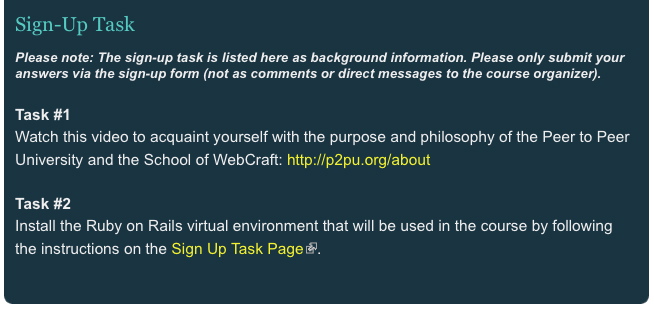
So you’ve proposed a course for the School of Webcraft. You’re awesome! We love you! But now you’re wondering: “What should I do next? How do I get ready? How do I make sure no one shoots spitballs at me on the first day of class?” The intrepid Pippa Buchanan and P2PU team offer this handy pre-flight checklist to follow before classes begin on January 26. Still got questions? Get in touch through the friendly School of Webcraft mailing list.
How to prep your course for blast off
Once you’ve proposed your School of Webcraft course through the P2PU site, here’s a pre-flight checklist:
1) Sign up for a course design orientation session
Run by Peer 2 Peer University, these sessions are a great way to
- find out more about facilitating peer-learning
- ask questions of past and present course organizers
- get guidance about designing and managing learning groups.
2) Refine your course design
You can start by…
- reading the Course Design Handbook
- there’s a section dedicated specifically to designing courses for the School of Webcraft
- pay particular attention to the Course Checklist
- have a look at examples from other successful Webcraft courses.
Dan Diebolt’s jQuery course, for example, is an excellent example to follow. You’ll notice that:
- the sign-up task is well-defined,
- there’s clear information about the weekly topics, tasks and readings; and
- it refers to openly licensed materials where available.
3) Define a sign-up task
Not everyone who applies to take your course will be the right fit. Your course’s sign-up task will help you determine which applicants have the right prerequisite knowledge, motivation and readiness for your course.
You can ask potential learners to define a personal learning goal, and make sure they sufficiently understand what peer learning and the School of Webcraft are all about. And also give them a specific technical task that’s relevant to the topic and prerequisites of your course. Some examples of good sign-up tasks from past School of Webcraft courses:
- Dan Diebolt’s jQuery course
- Andy Lindeman’s Introduction to Ruby and Rails
- Bryan Gould’s Alt Text and Universal Design
4) Map out your weekly course topics
Creating a course plan in advance, with clearly defined topics for each week, will help you and your course participants. To make your outline even stronger, you can ask for feedback on your course plan from the School of Webcraft community list and from the peers you accept into your course. This will help you adapt it to the specific needs and interests of your peers.
5) Let us know you’re ready for blast off
Finished these steps? Let us know your course is ready through the School of Webcraft mailing list, so that we can review it and switch your course status from “draft in progress” to “open” so that peers can apply. Your next mission: reviewing submissions from those who apply to take your course. More on that in an upcoming post!




Cheers for this!